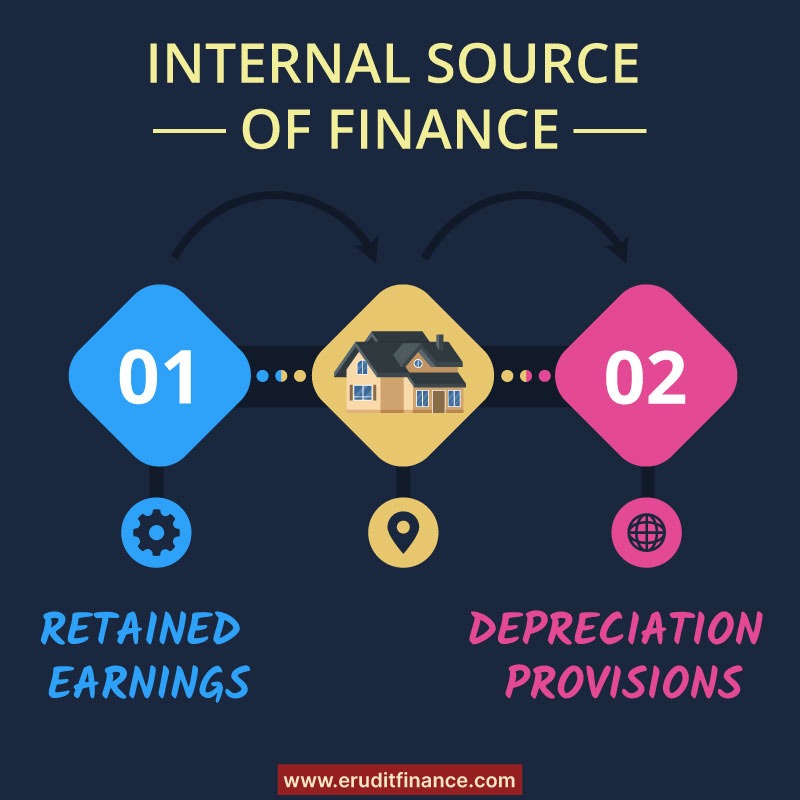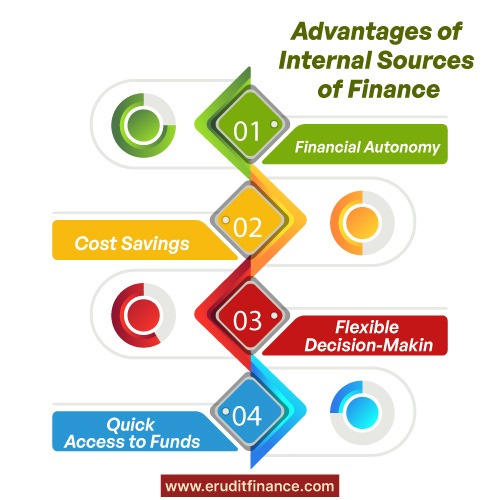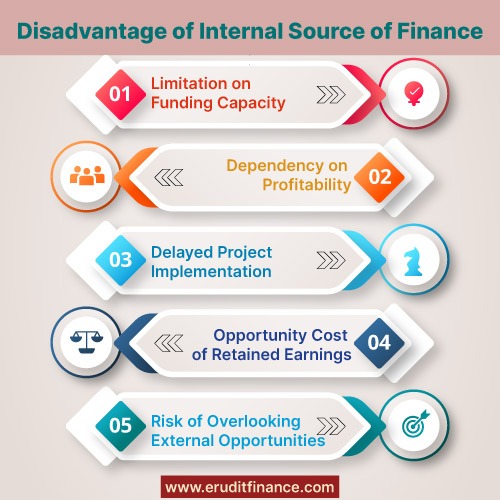Introduction
Internal Source of finance represent funds generated within a company, providing a self-sustaining financial foundation. These sources, including retained earnings and depreciation provisions, empower businesses to fund operations, expansions, and investments without relying on external borrowing. Harnessing the company’s resources, and internal finance fosters financial independence, enhances flexibility, and reinforces strategic decision-making.
What Is Internal Source of Finance?

Internal sources of finance refer to funds generated within a company to meet its financial needs without resorting to external borrowing.
These sources are derived from the company’s operations and activities.
Two primary internal sources of finance are retained earnings and depreciation provisions.
Retained Earnings:
Profits that have remained in a firm and yet not allocated in the form of dividends to owners are known as retained earnings. As such, such profits are plowed back into the business sector. Such income-based financing enables firms to undertake different exercises, for instance, research and innovation or growth, as well as debt repayment.
Depreciation Provisions:
Depreciation is a non-cash expense that reflects the wear and tear on assets over time. While it reduces the reported profit, it also creates an internal source of funds. By setting aside a portion of profits as a depreciation provision, companies can accumulate funds for replacing or upgrading assets when needed.
Internal sources of finance provide several advantages. They offer financial autonomy, reducing dependence on external lenders and mitigating interest costs. Additionally, these funds are usually more readily available, providing flexibility in decision-making. However, the amount of funds generated internally is contingent on the company’s profitability, and businesses must strike a balance between retaining earnings and distributing dividends to shareholders. Overall, internal sources of finance contribute to a company’s financial stability and strategic flexibility.
Advantages and Disadvantages of Internal Sources of Finance
Advantages of Internal Sources of Finance

Financial Autonomy- Utilizing internal sources of finance, such as retained earnings, grants companies financial autonomy. They can fund projects and activities without relying on external lenders or investors, reducing dependence on external factors.
Reduced Dependency on External Debt- Internal financing reduces the need for external debt, minimizing interest costs and associated financial obligations. This can lead to improved financial health and flexibility.
Flexible Decision-Making- Internal sources of finance provide flexibility in decision-making. Companies can allocate funds based on strategic priorities, whether it’s investing in research and development, expanding operations, or reducing debt.
Stability in Economic Downturns- During economic downturns, companies may face challenges in accessing external financing. Internal sources, like retained earnings, offer a stable and dependable reservoir of funds, helping companies weather economic uncertainties.
Cost Savings- Internal financing avoids interest payments associated with external loans, resulting in cost savings for the company. This can enhance overall profitability and financial efficiency.
Quick Access to Funds- Internal funds are usually readily available, providing quick access when needed. This agility is beneficial for addressing immediate financial needs or seizing opportunities.
Disadvantages of Internal Sources of Finance

Limitation on Funding Capacity- The amount of funds available through internal sources is limited by the company’s profitability and accumulated retained earnings. This limitation may restrict the scale of projects or investments a company can undertake.
Opportunity Cost of Retained Earnings- Retaining earnings means not distributing them as dividends to shareholders. While this helps fund internal projects, it might be perceived as an opportunity cost by investors seeking dividend income.
Risk of Overlooking External Opportunities- Relying solely on internal sources might lead a company to overlook external investment opportunities that could be beneficial for growth and diversification.
Dependency on Profitability- The availability of internal funds is contingent on the company’s profitability. Economic downturns or periods of low profitability can limit the amount of funds generated internally.
Delayed Project Implementation- Internal financing might lead to delays in project implementation if the company needs time to accumulate sufficient funds. External financing could offer a faster route to capital.
Limited Resource Allocation- Internal sources might limit the scope of resource allocation. Large-scale projects or acquisitions may necessitate external financing to meet funding requirements.
In conclusion, while internal sources of finance provide businesses with financial autonomy, flexibility, and cost savings, they are not without limitations. Striking a balance between internal and external financing allows companies to harness the advantages of both and optimize their financial structure based on strategic objectives and prevailing economic conditions.
How Internal Sources of Finance Is Used in the Industrial Concern
Internal sources of finance are crucial for industrial concerns, providing a reliable means to fund various activities and initiatives. Here’s how industrial concerns commonly use internal sources of finance.

1). Capital Expenditures: Several industrial problems rely on internal resources such as retained earnings for funding operating expenses. These are the buying of machinery, technology, and equipment for manufacturing and operations efficiency.
2). Research and Development (R&D): Investing in research and development is vital for industrial concerns to innovate and stay competitive. Internal sources of finance, particularly retained earnings, are employed to fund R&D projects aimed at developing new products, and processes, or improving existing ones.
3). Expansion Projects: Industrial firms looking to expand their production capacity or enter new markets can use internal funds to finance expansion projects. This may involve constructing new facilities, increasing production lines, or establishing additional manufacturing units.
4). Working Capital Management: Internal sources of finance are instrumental in managing working capital, covering day-to-day operational expenses such as raw materials, labor costs, and overhead. This ensures the smooth functioning of industrial operations without relying solely on external financing.
5). Debt Repayment: Internal funds, especially profits generated from operations, are often allocated to debt repayment. This helps industrial concerns reduce their outstanding liabilities, enhancing financial stability and reducing interest costs associated with external debt.
6). Technology Upgrades: To stay technologically competitive, industrial concerns invest in periodic upgrades to their technology infrastructure. Internal sources of finance support these initiatives, enabling the adoption of advanced machinery and systems.
7). Employee Training and Development: Utilizing internal funds, industrial concerns can invest in the training and development of their workforce. This includes skill development programs, safety training, and other initiatives to enhance employee capabilities and efficiency.
8). Environmental and Sustainability Initiatives: Many industrial concerns prioritize environmental and sustainability initiatives. Internal funds can be directed towards implementing eco-friendly technologies, waste reduction measures, and other sustainability projects.
9). Dividend Payments: While not a direct investment in business operations, industrial concerns may use internal funds to pay dividends to shareholders. This can be seen as a way to share profits with investors while still retaining a portion for reinvestment.
10). Contingency Reserves: Internal sources of finance allow industrial concerns to build contingency reserves. These reserves serve as a financial cushion for unforeseen circumstances, economic downturns, or emergencies, ensuring financial resilience.
By leveraging internal sources of finance, industrial concerns can maintain financial independence, strategically allocate resources, and fund essential initiatives for sustained growth and competitiveness in their respective markets. The prudent use of retained earnings and other internal funds contributes to the overall financial health and stability of industrial enterprises.
Why Use Internal Sources of Finance?
Using internal sources of finance offers several advantages for businesses, making it a strategic and prudent choice. Here are key reasons why businesses opt for internal sources of finance.

Financial Autonomy- Internal financing provides businesses with a level of financial autonomy. Relying on retained earnings and other internal sources means less dependence on external lenders or investors, allowing the company to retain control over its financial decisions.
Reduced Dependency on External Debt- With internal funding, the dependence on external debt is cut down. As a result, this reduces financial burdens due to interests and creates more room for financial flexibility for the company.
Cost Savings- Businesses prefer internal financing as they evade the interest costs of outside loans. Consequently, this helps reduce expenses, translating to higher profits, and efficient use of finances.
Flexible Decision-Making- Internal sources of finance offer flexibility in decision-making. Businesses can allocate funds based on strategic priorities, whether it’s investing in expansion, research, and development, or debt reduction, without external constraints.
Stability in Economic Downturns- During economic downturns or periods of financial uncertainty, internal sources of finance, such as retained earnings, provide a stable and dependable reservoir of funds. This stability enhances the company’s ability to weather economic challenges.
Quick Access to Funds- Internal funds are usually readily available, providing quick access when needed. This agility is beneficial for addressing immediate financial needs or capitalizing on business opportunities without delays associated with external financing.
Enhanced Financial Planning- Internal financing allows for enhanced financial planning. Businesses can plan and execute strategic initiatives with more precision, knowing that they have a reliable source of funds from their operations.
Ownership Retention- By using internal funds, businesses retain ownership control and avoid dilution of ownership that may occur with external equity financing. This is particularly important for businesses wanting to maintain control over their operations.
Risk Mitigation- Internal sources of finance help mitigate certain risks. Unlike external financing, which may have specific terms and conditions, internal funds offer more flexibility, reducing exposure to external market fluctuations.
Alignment with Profitability- Internal funds are directly linked to a company’s profitability. As the business grows and generates profits, it accumulates internal funds, allowing for a natural alignment between financial resources and the company’s success.
Retained Earnings for Reinvestment- Retained earnings, a significant internal source of finance, enable businesses to reinvest profits back into the company. This reinvestment supports growth initiatives, innovation, and the overall development of the business.
In conclusion, businesses use internal sources of finance to maintain financial independence, reduce costs, and strategically allocate resources. The flexibility, stability, and control afforded by internal financing make it an essential component of sound financial management for companies across various industries.
Is Internal Finance Free?
While internal finance, particularly funds generated from retained earnings, is often considered “free” in the sense that it doesn’t involve explicit interest payments or external obligations, it is not entirely without cost. Internal finance comes with certain implicit costs and considerations that businesses need to be mindful of:
Opportunity Cost: Retained earnings represent profits that are not distributed as dividends to shareholders. The opportunity cost of using internal finance is the foregone opportunity for shareholders to receive dividend income. Shareholders could potentially invest these dividends elsewhere for a return.
Cost of Equity: The cost of equity is an implicit cost associated with using internal finance. When a company retains earnings rather than distributing them as dividends, shareholders expect the value of their shares to increase. This increase reflects the cost of equity, as shareholders forgo immediate cash dividends in anticipation of future gains.
Share Price Impact: Retaining earnings can influence a company’s share price. While investors may appreciate the reinvestment of profits for growth, any decisions regarding dividend distribution or retention can impact how the market values the company’s shares.
Investment Decision Implications: Using internal finance for investments or projects may limit the available funds for other opportunities or initiatives. Businesses need to carefully consider the allocation of retained earnings to ensure they are maximizing shareholder value.
Perceived Risk: Investors may perceive the retention of earnings as a conservative approach, potentially affecting the company’s risk profile. This perception can influence how the market views the company and its valuation.
Impact on Shareholder Relations: Decisions regarding the use of internal finance can influence relations with shareholders. Communication and transparency about the company’s financial strategy and use of retained earnings are crucial to maintaining positive shareholder relations.
While internal finance avoids explicit costs such as interest payments associated with external borrowing, businesses must weigh these implicit costs against the benefits of financial autonomy, flexibility, and control. Careful consideration and clear communication with shareholders are essential to strike a balance that aligns with the company’s strategic objectives and shareholder expectations.
Bottomline:-
In essence, internal sources of finance, though not entirely free, offer businesses a valuable reservoir of funds derived from retained earnings and operational activities. While there are implicit costs related to opportunity and equity, the financial autonomy, flexibility, and stability provided by internal finance make it a strategic choice. By judiciously balancing reinvestment with shareholder expectations, businesses can leverage internal funds to drive growth, innovation, and financial resilience, fostering a sustainable and sound financial foundation.
Also Read:-










